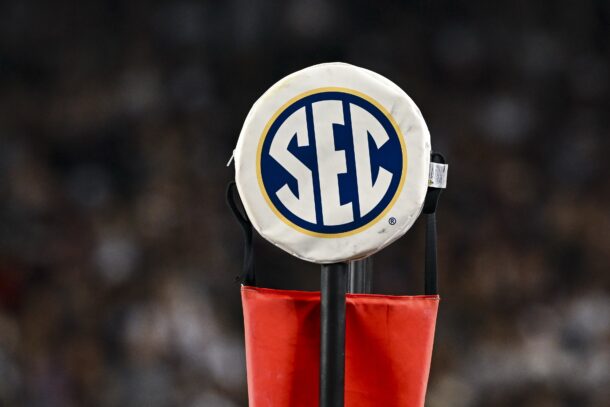
Texas A&M vs. LSU features 2 SEC West programs trending in opposite directions.
Statistically speaking, this is a fascinating matchup. Texas A&M brings a relatively balanced profile to the table. The Aggies are borderline elite defensively while their offense has been above-average vs. a SEC schedule. LSU, meanwhile, has a truly elite offense led by quarterback Jayden Daniels and a defense that has put up very little resistance for much of the 2023 campaign.
Both teams will be desperate to avoid another loss going into the postseason. If LSU wins, it will move to 9-3 on the season and clinch a share of second place in the SEC West. But a loss would mean the Tigers fall to 5-3 in SEC play and remove the possibility of back-to-back 10-win seasons to start off Brian Kelly’s tenure as head coach. Texas A&M parted ways with coach Jimbo Fisher earlier this month, clearing the way for a new era to start in 2024.
Let’s examine some betting trends, advanced stats and other useful info about these teams:
Texas A&M vs. LSU Betting Lines
Spread: LSU -11 (DraftKings)
Total: Over/under 66 points (DraftKings)
Check out these excellent sports betting apps to get in on the action ahead of Saturday’s big SEC game.
Betting trends to know for Texas A&M
- Texas A&M is 5-5-1 against the spread this season
- The over is 6-5 in Texas A&M games this season
- Texas A&M is 1-2-1 against the spread on the road this season
- Texas A&M is 0-2-1 against the spread as the underdog this season
Texas A&M has struggled as an underdog this season. The Aggies are 0-2-1 as dogs, although they did keep all three of those contests relatively close. This marks the first time this season that Texas A&M has been an underdog by more than 3 points.
Betting trends to know for LSU
- LSU is 7-4 against the spread this season
- Covered 5 of its last 6
- The over is 10-1 in LSU games this season
- The lone exception was in Week 12 vs. Georgia State
- LSU is 5-1 against the spread at home this season
- LSU is 7-3 against the spread as the favorite this season
Betting the over on LSU games has been one of the most profitable things a bettor could do this season. The Tigers finally went under last week as they were unable to hit a preposterously-high total of 75 points against Georgia State. LSU has also been very good against the spread this season, especially as a favorite. Their last ATS loss as the favorite was way back on Sept. 30 against Ole Miss.
Résumé rankings
Via ESPN’s Football Power Index:
- Texas A&M strength of schedule: 33rd
- LSU strength of schedule: 10th
- Texas A&M strength of record: 33rd
- LSU strength of record: 14th
Advanced Stats preview
Success rate will be the primary tool referenced in this section. Whether or not a play is “successful” depends on the down and distance of a given play. Here’s a breakdown of how much yardage is necessary for a play to be deemed “successful”:
- 1st down: Teams must gain at least 50% of required yardage
- 2nd down: Teams must gain at least 70% of required yardage
- 3rd or 4th down: Teams must gain 100% of required yardage
Defensively, numbers are presented as what the defense allowed the offense to achieve. So on defense, a 35% success rate is better than a 40% success rate.
Let’s dig into what success rate says about this matchup:
Rushing Success Rate
- Texas A&M rushing offense success rate: 45% (64th percentile)
- LSU rushing defense success rate: 46% (24th percentile)
Texas A&M’s offense hasn’t been elite this season, but the Aggies should still have the advantage over a troublesome LSU defense. However, the early returns on A&M’s offense without Fisher are not good. Facing Abilene Christian last week, A&M posted a rushing offense success rate of just 44% (excluding garbage time). That’s just below A&M’s season-long average despite facing FCS competition last week. If the Aggies are going to have a chance vs. LSU, they will need to have a stronger performance in the run game.
- LSU rushing offense success rate: 59% (100th percentile)
- Texas A&M rushing defense success rate: 32% (97th percentile)
This is strength-on-strength. No one has been able to stop LSU’s rushing attack this season — or really anything the Tigers’ offense tries to do. LSU has scored multiple rushing touchdowns in all but 1 game so far this season. They’re also averaging 6.4 yards per carry in 2023.
Defensively, Texas A&M’s rush defense is amongst the best nationally, as well. No team has rushed for more than 4.7 yards per carry on the Aggies this season. LSU is first in rushing yards per attempt in the SEC, but the Aggies help up relatively well against the No. 2 team in Tennessee. The Vols did rush for 232 yards in that game, but it took them 49 attempts to get to that total.
Passing Success Rate
- Texas A&M passing offense success rate: 43% (55th percentile)
- LSU passing defense success rate: 45% (16th percentile)
LSU’s defense has really struggled vs. the pass this season, but it’s unclear if Texas A&M will be good enough to take advantage of that weakness. Again, A&M posted an underwhelming (relative to the opponent) passing success rate of 48% last week vs. Abilene Christian. Quarterback Jaylen Henderson will be making the first road start of his Texas A&M career at Tiger Stadium on Saturday.
- LSU passing offense success rate: 55% (99th percentile)
- Texas A&M pass defense success rate: 38% (83rd percentile)
Jayden Daniels may well clinch the Heisman Trophy this weekend if he has a strong game against a competent Texas A&M secondary. Daniels is averaging a staggering 11.8 yards per attempt this season.
LSU has by far the best passing efficiency rating (195.98) of any team in the SEC. However, other top passing attacks have given A&M a lot of trouble. Ole Miss threw for 387 yards on 33 attempts vs. Texas A&M. Alabama went for 321 yards on 33 attempts. There’s no evidence to suggest that Texas A&M can stop a passing attack that’s as efficient as LSU’s has been this season.
Havoc rate
A havoc play is defined as a play where the defense records a tackle for loss, a forced fumble, an interception or a pass breakup.
For defenses, a higher havoc rate is good. Offensively, havoc rates are presented as what the offense allowed the defense to create. On that side of the ball, the lower the havoc rate, the better it is for your offense.
Here’s a breakdown of this matchup:
- Texas A&M offensive havoc rate: 15% (61st percentile)
- LSU defensive havoc rate: 17% (50th percentile)
This looks to be a pretty even matchup. LSU’s havoc rate is maybe even a little higher than you’d expect for a defense that has struggled so much this season. Texas A&M does a good job of limiting tackles for loss — something it will need keep doing this weekend as it takes a third string quarterback into Tiger Stadium.
- LSU offensive havoc rate: 11% (98th percentile)
- Texas A&M defensive havoc rate: 24% (99th percentile)
This side of the matchup is fascinating. On one end, LSU has allowed just 31 tackles for loss so far this season — by far the best total of any SEC team. On the other end, no one gets more tackles for loss than Texas A&M (94). A&M’s ability to create negative plays in big spots has been its biggest advantage defensively all season. Will that translate vs. an elite offense like LSU’s? That’s the question that will likely determine whether or not Texas A&M can hang around in this game.
Points per opportunity
A scoring “opportunity” is defined as a possession in which the offense has moved the ball beyond the opponents’ 40-yard line. This stat measures how effective a team is at cashing on its scoring chances — or preventing them from their opponents.
- Texas A&M points scored per opportunity: 4.15 (66th percentile)
- LSU points allowed per opportunity: 4.56 (6th percentile)
LSU’s defense has been a total pushover on scoring opportunities. The Tigers have allowed points on 35-38 defensive red zone possessions so far this season — a rate of 92.1%, which is good for dead last in the SEC. LSU has also allowed 28 red zone touchdowns this season, which is tied for the worst mark in the SEC. LSU has a red zone touchdown allowed rate of 73.7%, which is also last in the SEC.
- LSU points scored per opportunity: 5.16 (100th percentile)
- Texas A&M points allowed per opportunity: 2.75 (95th percentile)
LSU does make up for its lack of resistance defensively with an offense that is both opportunistic and ruthless. The Tigers have scored touchdowns on 73.2% of their red zone possessions this season. They rarely have to settle for field goals in the red zone, too. Even if you get them into 3rd-and-long, the Tigers seem to convert at a wildly-efficient rate. LSU has a passing down success rate of 46%, which is in the 100th percentile nationally.
Texas A&M’s defense has been stingy in the red zone this season. The Aggies have conceded a field goal on 9-of-26 defensive possessions so far this season while limiting opponents to just 12 touchdowns in those opportunities. That’s the best touchdown rate in the red zone (46.15%) for any defense in the SEC this season.
Tracking efficiency
- Texas A&M offense: 27th
- Texas A&M defense: 9th
- Texas A&M special teams: 68th
- LSU offense: 1st
- LSU defense: 103rd
- LSU special teams: 104th
- Texas A&M offense: 21st
- Texas A&M defense: 12th
- Texas A&M special teams: 82nd
- LSU offense: 2nd
- LSU defense: 59th
- LSU special teams: 86th
Note: All advanced stats mentioned in this story are from CollegeFootballData.com unless otherwise noted. Betting trends are via the Sports Betting Dime database.
Spenser is a news editor for Saturday Down South and covers college football across all Saturday Football brands.







